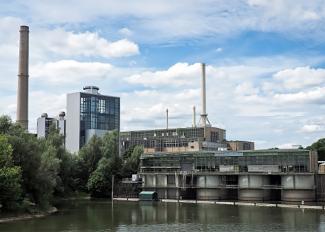A new, open-source computer model to quantify baseline life cycle impacts of electricity consumption in the United States is allowing for more robust and consistent analyses to inform decision makers and stakeholders.
Developed through a collaboration among NETL, the U.S. Environmental Protection Agency, and the National Renewable Energy Laboratory, the model is transparent and multifunctional for users.
The electricity and power generation sector in the U.S. is experiencing a state of rapid transformation via adoption of natural gas-fired power plants and deeper penetration of renewables into the market as older power-generation systems such as nuclear and legacy coal plants are gradually phased out.
However, this historic shift in the supply and demand of electricity and diversification of power generation technologies may have unintended environmental consequences due to resource consumption and emissions affecting land, water and soil. Furthermore, given the fundamental importance of power generation to national energy security and existing economic supply chains, addressing contemporary energy and environmental challenges requires a systems-level understanding of U.S. electric power and its associated impacts over the entire life cycle.
Life cycle analysis (LCA) examines the impacts associated with how purchased utility inputs can contribute significantly to the overall cradle-to-grave results for the system or product under evaluation, such as power plants and electricity use. Despite these factors, there was no comprehensive, transparent, and bottom-up LCA model for electric power in the U.S. until now.
“With this model publicly available, everyone from small communities to major industrial developers will have the ability to conduct in-depth analyses on domestic electricity use and its effects, every step of the way,” said Tim Skone, with NETL’s Energy Systems Analysis Team. “By providing stakeholders with the means to assess environmental impacts, this is another way the Lab is facilitating informed and responsible use of our nation’s energy resources.”
The model’s framework connects inventory data collected from via various EPA reporting programs with fossil supply chain and non-fossil inventory data. The EPA emissions inventory data is accessed using Standardized Emission and Waste Inventory Python modules. NETL’s contributions included supply chain data for fossil fuels based on detailed bottom-up engineering-based models for fuel extraction, processing and delivery.
NETL also updated LCA models for non-fossil technologies including nuclear, hydropower, solar and wind in consultation with experts from across U.S. Department of Energy (DOE). The emissions data is coupled with power plant generation data collected by the Energy Information Administration (EIA). As part of this effort, NETL endeavored to provide LCA results for electricity consumption mixes, not just generation mixes. To do so, the Lab’s LCA Team utilized transaction data tracked by the EIA and coupled it with an input-output trading algorithm to calculate the net consumption mix for every balancing authority in the U.S.
NETL’s LCA Team resides within the Energy Systems Analysis Team of the Lab’s Systems Engineering and Analysis directorate of the Research & Innovation Center.
The NETL co-developed LCA model will be released on the Federal LCA Commons repository. Users will also be able to access it via the Grid Mix Explorer, Version 4.2, an Excel-based results interface hosted on the NETL LCA website.
NETL is a DOE national laboratory that produces technological solutions for America’s energy challenges. From developing creative innovations and efficient energy systems that make coal more competitive, to advancing technologies that enhance oil and natural gas extraction and transmission processes, NETL research is providing breakthroughs and discoveries that support domestic energy initiatives, stimulate a growing economy, and improve the health, safety, and security of all Americans. Highly skilled men and women at NETL’s sites in Albany, Oregon; Anchorage, Alaska; Houston, Texas; Morgantown, West Virginia; and Pittsburgh, Pennsylvania conduct a broad range of research activities that support DOE’s mission to advance the national, economic, and energy security of the United States.




